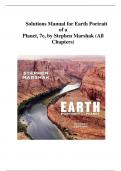Exam (elaborations)
Solutions Manual for Earth: Portrait of a Planet 7th Edition by Stephen Marshak , ISBN: 9780393882742 |COMPLETE TEST BANK| Guide A+
- Course
- Institution
- Book
Solution Manual For Earth Portrait of a Planet, 7th Edition by Marshak, ISBN: 9780393882742, All 23 Chapters Covered, Verified Latest Edition Solution Manual For Earth Portrait of a Planet, 7th Edition by Marshak, ISBN: 9780393882742, All 23 Chapters Covered, Verified Latest Edition Solution Manual...
[Show more]



